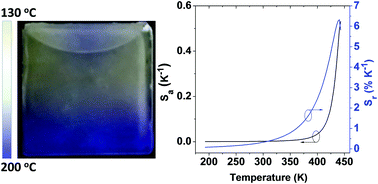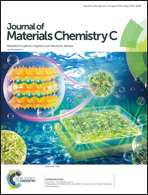Feasible organic films using noninterfering emitters for sensitive and spatial high-temperature sensing†
Abstract
Solid-state ratiometric thermometers for high-temperature and gradient thermosensing are important for industrial and scientific communities, but are difficult to fabricate. This is because the emission is always significantly quenched at high temperatures due to much facilitated nonradiative decay. Moreover, in mixtures of different-colored emissive species, inevitable energy transfer generally makes the distinction in thermal responses of the individual emitters much less marked. In this work, we have developed a feasible strategy to realize thermo-sensitive solid films for wide-range (−80 to 200 °C) and high temperature measurements, by blending a temperature inert blue emitter with a temperature-sensitive yellow emitter with a large Stokes shift. The minimum spectral overlap ensures the blocking of energy transfer, thus enabling these two emitters to exhibit their distinct thermal responses without significant mutual influences. Due to the thermally-populated bright local excited state in the blue emitter, the temperature sensitivity abnormally increases with an increase of temperature. The relative sensitivity is higher than 1% K−1 when the film is heated to over 362 K, reaching a maximum of 6.32% K−1 at 440 K. More importantly, the films exhibit good thermo-mapping and reversible sensing capabilities in ambient atmosphere, indicating great potential for low-cost, robust, large-area and gradient wide range and high-temperature thermometers.



 Please wait while we load your content...
Please wait while we load your content...